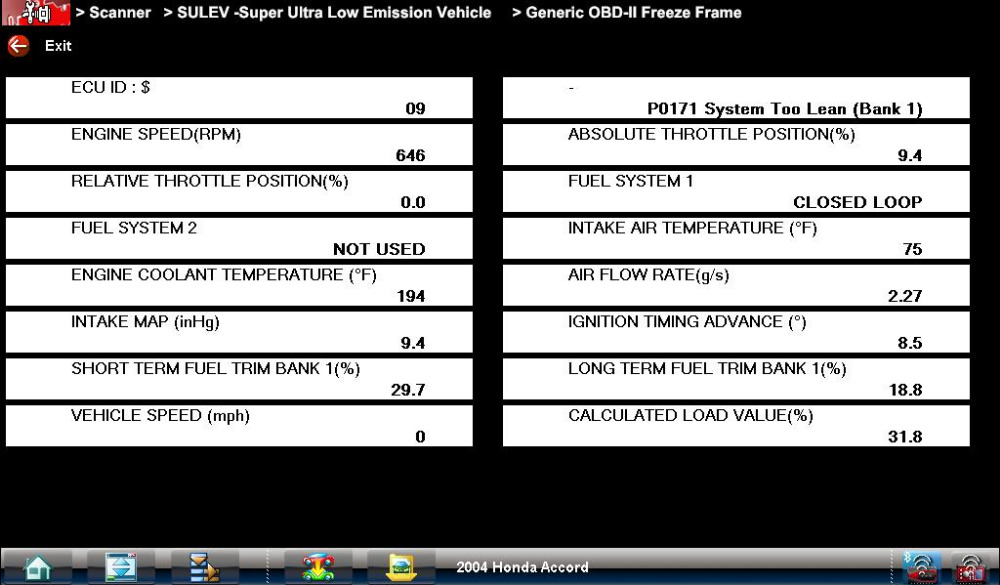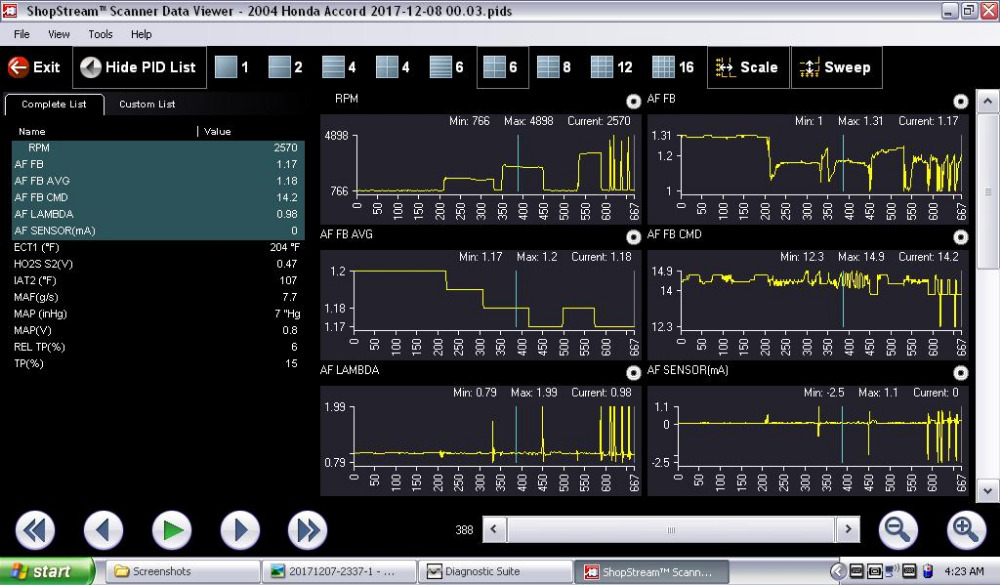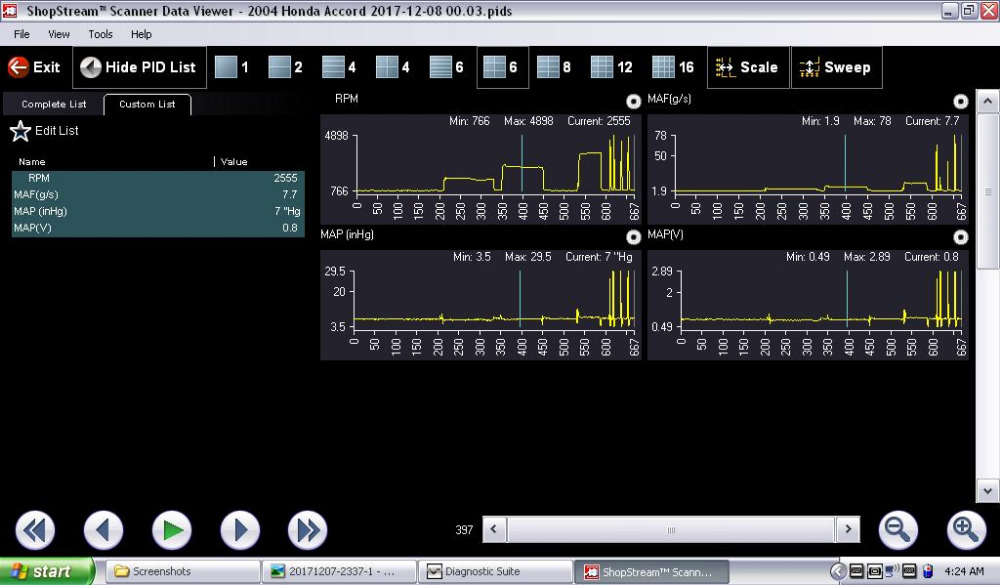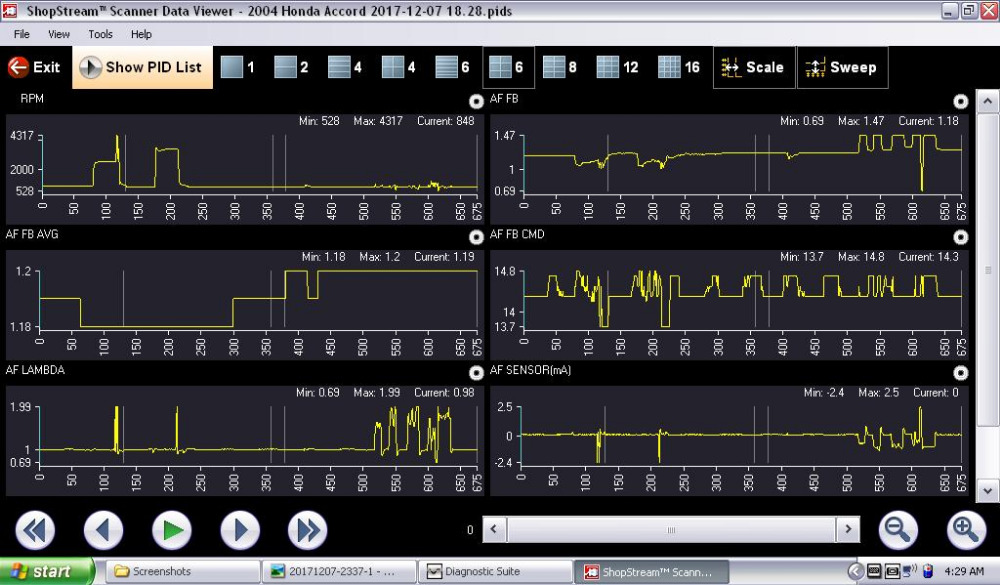*** Restricting New Posts to SD Premium Members ONLY *** (09 May 2025)
Just made a new account? Can't post? Click above.
2004 Honda Accord - P0171 -
- newspeed
-
Topic Author
- Offline
- New Member
-

- Posts: 5
- Thank you received: 0
I'm new to the forum and new to auto diagnostics in general and am looking for a little advice.
2004 Honda Accord 2.4L AT - Check engine light on, code P0171 - Fuel Metering Too Lean -
Drives perfect with no apparent symptoms other than the light. No misfires or hesitation. Has a minor pulsing vibration at idle but otherwise stable.
Performed a smoke test and found no vacuum leaks. Valves lash was recently adjusted and is within spec. ECT is normal and always between 190-210F in closed loop. IAT reading is normal as well. I don't think its a fuel delivery issue because the car shows no power loss and drives great.
STFT is positive 20ish %.
LTFT is positive 18ish %
Raising the RPMs seems to lower the STFT single digit number but soon returns high after RPMs stabilize. LTFT drops a couple points but always remains in the high teens.
MAF numbers seem to be responding normally. I am new to AF sensors but they seems to adjust normally when i create lean condition/rich condition. Lambda is always close to 1.0 but the fuel trims remain high.
I provided some screen shots of testing I performed. I can provide additional screenshots if needed on request. I'm not sure where to look next and any advice would be greatly appreciated.
Please Log in or Create an account to join the conversation.
- cheryl hartkorn
-
- Offline
- Platinum Member
-

- Posts: 692
- Thank you received: 130
Please Log in or Create an account to join the conversation.
- newspeed
-
Topic Author
- Offline
- New Member
-

- Posts: 5
- Thank you received: 0
The STFT lowers when raising the throttle only temporarily. After holding it steady at 2500 rpms it climbs right back to high numbers. The LTFT stays high always.
I checked the Purge valve and its not leaking or open. At idle, I disconnected the hose that runs from the purge valve to the TB and sealed off the open TB port with my finger. STFT went down only a few points but remained high around 20%.
Did a similar test with PCV. Closed off the hose and trim did not normalize.
Saw no leaks near the brake booster during smoke test.
Please Log in or Create an account to join the conversation.
- Ben
-
- Offline
- Platinum Member
-

- Posts: 1097
- Thank you received: 215
Sent from my SM-G928P using Tapatalk
Please Log in or Create an account to join the conversation.
- Ben
-
- Offline
- Platinum Member
-

- Posts: 1097
- Thank you received: 215
Sent from my SM-G928P using Tapatalk
Please Log in or Create an account to join the conversation.
- newspeed
-
Topic Author
- Offline
- New Member
-

- Posts: 5
- Thank you received: 0
Please Log in or Create an account to join the conversation.
- fudgie
-
- Offline
- Senior Member
-

- Posts: 48
- Thank you received: 4
Please Log in or Create an account to join the conversation.
- newspeed
-
Topic Author
- Offline
- New Member
-

- Posts: 5
- Thank you received: 0
What you are seeing with the MAF at 1.9g/s on the min scale was only momentary. It most likely happened when I pulled a vaccum hose to induce a lean condition and the engine stumbled and almost stalled.
At idle its normally around 2.2-2.5g/s. 2500 rpm around 7.7g/s. 4500 rpm around 17-18g/s. According to the Honda FSM these numbers are all within spec.
Please Log in or Create an account to join the conversation.
- newspeed
-
Topic Author
- Offline
- New Member
-

- Posts: 5
- Thank you received: 0
Please Log in or Create an account to join the conversation.
- fudgie
-
- Offline
- Senior Member
-

- Posts: 48
- Thank you received: 4
Please Log in or Create an account to join the conversation.
- Drunken Elvis
-
- Offline
- New Member
-

- Posts: 18
- Thank you received: 1
Is there an update program or "flash" for the engine management computer?
Please Log in or Create an account to join the conversation.
- John Clark
-
- Offline
- Premium Member
-

- Posts: 139
- Thank you received: 46
I had higher than normal fuel trims (in the 15-20% range on both ST and LT) but not yet enough to set a lean code. The numbers didn't change with increasing RPM but I checked everywhere for vacuum leaks anyway and found nothing. MAF numbers showed good. I didn't check fuel pressure (Honda makes that difficult) but I could make the downstream O2's go rich on WOT so didn't suspect fuel delivery. Since it was my own, and I had 170K on the vehicle, I opted to replace both upstream A/F sensors with new NTK (the OEM) sensors. I initially saw an improvement on the fuel trims but when I checked the vehicle a few days later I found it back to around 10-15% on ST and LT fuel trims, still some improvement but not as much as I'd wanted.
I then opted to replace both downstream O2 sensors with new NTK's. After replacing both downstream sensors and doing a PCM reset with the scan tool I saw great improvement. After a week I was seeing slightly negative fuel trim numbers and the vehicle has been running perfect every since.
The odd part of it is the sensors passed every test that I knew of. I was able to make the downstreams go lean and rich as they should. However, after replacing all four everything was back to normal and the car runs like it did the day I drove it off the lot with 6 miles on it back in 2008.
The downstream sensors in these cars DO contribute to fuel trim so if they are skewed in any way, or if the upstreams are skewed, it will send bad data back to the PCM. Combine that with the increased difficulty of diagnosing wideband O2's that are used in the upstream position and it really threw me until I took the guess and put four new O2's in the car.
I know this is not real helpful from a diagnostic standpoint but if those O2's are original and have a lot of miles on them I've found it's a good idea to swap them out. I had an 09 Pilot come in w/155K on it, with increased fuel trim numbers and complaint of reduced fuel economy...replaced all four O2's on that rig and saw the same fix.
Please Log in or Create an account to join the conversation.
- Tutti57
-

- Offline
- Platinum Member
-

- Posts: 1096
- Thank you received: 253
Is this something that could be verified with a scope? Maybe a slow response or not as many oscillations?John Clark wrote: Does this car use wideband O2's on the upstream? One thing I have learned about these Hondas is that the O2's can get skewed over time and mileage. If this thing has over 125K on it I'd recommend replacing both O2 sensors with new Denso (the OEM) sensors. I realize this is a parts cannon approach but I found a similar scenario with my 2008 Odyssey.
I had higher than normal fuel trims (in the 15-20% range on both ST and LT) but not yet enough to set a lean code. The numbers didn't change with increasing RPM but I checked everywhere for vacuum leaks anyway and found nothing. MAF numbers showed good. I didn't check fuel pressure (Honda makes that difficult) but I could make the downstream O2's go rich on WOT so didn't suspect fuel delivery. Since it was my own, and I had 170K on the vehicle, I opted to replace both upstream A/F sensors with new NTK (the OEM) sensors. I initially saw an improvement on the fuel trims but when I checked the vehicle a few days later I found it back to around 10-15% on ST and LT fuel trims, still some improvement but not as much as I'd wanted.
I then opted to replace both downstream O2 sensors with new NTK's. After replacing both downstream sensors and doing a PCM reset with the scan tool I saw great improvement. After a week I was seeing slightly negative fuel trim numbers and the vehicle has been running perfect every since.
The odd part of it is the sensors passed every test that I knew of. I was able to make the downstreams go lean and rich as they should. However, after replacing all four everything was back to normal and the car runs like it did the day I drove it off the lot with 6 miles on it back in 2008.
The downstream sensors in these cars DO contribute to fuel trim so if they are skewed in any way, or if the upstreams are skewed, it will send bad data back to the PCM. Combine that with the increased difficulty of diagnosing wideband O2's that are used in the upstream position and it really threw me until I took the guess and put four new O2's in the car.
I know this is not real helpful from a diagnostic standpoint but if those O2's are original and have a lot of miles on them I've found it's a good idea to swap them out. I had an 09 Pilot come in w/155K on it, with increased fuel trim numbers and complaint of reduced fuel economy...replaced all four O2's on that rig and saw the same fix.
Sent from my Moto G Play using Tapatalk
Please Log in or Create an account to join the conversation.
- John Clark
-
- Offline
- Premium Member
-

- Posts: 139
- Thank you received: 46
Tutti57 wrote: Is this something that could be verified with a scope? Maybe a slow response or not as many oscillations?
Sent from my Moto G Play using Tapatalk
I have a thread here somewhere where I went through this. On the widebands there's nothing really to scope. You have to analyze them via scan tool. You can check heater circuits, of course.
As for the downstream sensor, if your cats are working there aren't a lot of oscillations to look at. I wasn't able to come up with any way to verify the sensors were skewed. They all appeared to work normally, yet after replacement my fuel trim issue was fixed.
I am far from an expert on this so take with a grain of salt. I do know what I've seen personally in a couple of cases with Honda. I'm a proponent of O2 sensors being a maintenance item. I wouldn't go more than 125-150K on them. The sensor manufacturers say 100K but, of course, I'm a skeptic and always assumed they just wanted to sell them. I don't think they're worn out at 100K but definitely by 150K they have outlived their useful life.
Please Log in or Create an account to join the conversation.




